I have a magnate on my refrigerator that says, “Change your shoes…Change your life.” The relationship between planting a garden and quality animal interactions may seem equally unconnected, but it’s not as far-fetched as you might think. Gardening teaches basic skills that carry over into all areas of life and I’d heartily recommend it for anyone who works with animals and/or wants a quality relationship with them. Consider the following and judge for yourself.
Knowing Your Limits. One of the first things that gardening teaches is to select plants or seeds that are compatible with your soil, climate, and degree of knowledge. This doesn’t mean that you can’t or shouldn’t consider something new and different. But if you do, it means that you have to make any changes necessary to ensure a compatible environment before you plant those seeds or plants.
For example, here’s a picture of my vegetable garden this year:
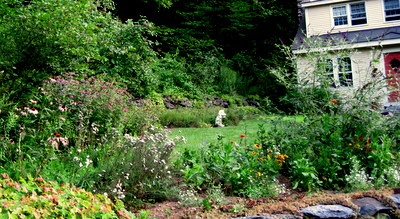
You might be thinking this is a good place to stop reading this commentary because I obviously don’t know the difference between a flower and a vegetable. But the truth is that this was a vegetable garden. But after two years of above average rainfall and other climatic changes that reduced my vegetable yield to next to nothing, I knew it was time to plant something else. I’ve always mixed flowers with the vegetables, but because I had no idea what this summer’s weather would bring, I decided to plant all flowers. I stuck with perennials with established track records surviving in a wide range of conditions. For additional color, I sowed a mixture of annual seeds, based on the hope that at least some of them would survive and even flourish in whatever conditions Mother Nature doled out this year.
Once you lose a plant or, worse, a whole garden because you didn’t take the time to understand your own and the limits or your environment, you’re more likely to think twice before buying or adopting animals from distant locations or losing your heart to a rare species, breed, or color before knowing those animals’ needs and ensuring that you can fulfill them.
Pruning. Gardening also teaches you that there are times when it’s necessary to cut a plant, shrub, or tree back in order for it to grow and flourish. Of all the lessons the garden has taught me, pruning and transplanting (more on that later) have been the hardest for me to learn. Remove too little and the plant won’t thrive. Remove too much and it will die. Timing is also important. Spring pruning is recommended for some plants, while fall pruning is optimum for others. If your timing is off, any benefits and even the plant could be lost.
For me, the hardest plants to prune were those I’d nursed for years that have lots of foliage, but few flowers or fruits. The thought of cutting back all that growth used to just about kill me, even though the science and logic behind the process was clear. But each time I summoned the courage to do it and saw the benefits the following year, it became easier.
A similar phenomenon can occur with animals. We invest in a particular feeding, training, exercise, and/or medical program and our animals do adequately, but never as well as we think they could or should. But the thought of starting over seems overwhelming after all we’ve invested in this approach. Then when finally muster the courage to start over—or things get so bad we have no choice—and we see the results, we wonder why we didn’t do it sooner.
Transplanting. Transplanting was another difficult lesson for me to learn and I learned it the hard way. I planted my seeds and when they sprouted, I couldn’t bear to thin them because I had no place to plant all the seedlings and didn’t want to lose them. As a result, I lost most of them anyway. And those that did survive didn’t do nearly as well as they would have had they had more room to grow.
But as the garden also teaches, nature is dynamic. Part of what looks like a mass of annuals in the first picture happened because the ideal time to transplant occurred when I was in Colorado this year. By the time I got back, weather conditions were such that it would have been more life-threatening to transplant than let them stay where they were. Even so, since then I’ve removed some plants that I can only describe as botanical bullies because they had such a suppressive effect on those around them.
With established perennials, I now accept that as soon as I get some of them to where I want them to be, it won’t be long until I’ll have to divide and transplant them if I want them to continue doing well. For example, in this bed the pink phlox are doing so well, they’re crowding out instead of complimenting the flowers behind them. Next year I’ll have to bite the bullet and divide the plants just as the first shoots poke out in the spring and move them to another location.

Meanwhile the plants growing behind them, a lovely daisy-like flower called Prairie Sun, are lost behind the taller phlox, so I plan to transplant them next spring, too, but for a different reason.
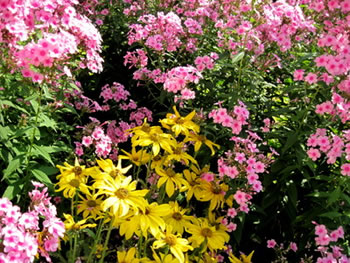
The plants in front of the phlox are hosta, a slow-growing clumping perennial that’s my idea of the perfect plant. Or it would be if it had just a bit more pizzazz. The nice thing about plants like this is that, the slower they grow, the less transplanting I need to do. But the slower they grow, the more unfinished the bed will look until they get established. That border was 20-odd years in the making.
Meanwhile, it’s hard to believe that, Mother Nature willing, this isolated lump of Gaillardia will one day merge with others I’ve planted in the beds by the front walk and live up to to their common name of blanket flower. When they do, they’ll cover all those unsightly rocks that are the norm in my soil.
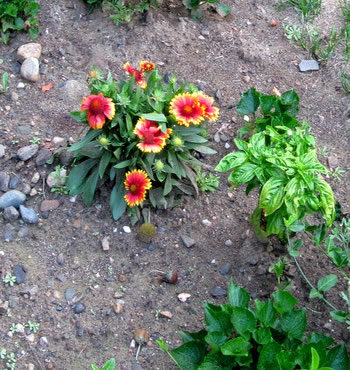 Other times transplanting becomes a necessity when the environment changes. When I knew the construction of a new drainage system would destroy some of my plants, I transplanted them to safer locations. Some of them will remain in their new locations, but I’ll move others back to their original places when the work is done.
Other times transplanting becomes a necessity when the environment changes. When I knew the construction of a new drainage system would destroy some of my plants, I transplanted them to safer locations. Some of them will remain in their new locations, but I’ll move others back to their original places when the work is done.
Does transplanting have a counter-part in the animal world? I think it does. Granted we don’t think in terms of dividing and rehoming parts of the Saint Bernard who outgrew the tiny apartment. But sometimes we do have to face the fact that our limited space may not be enough for a high-energy animal, or that 4 dogs or 5 cats or 20 birds may be too many for us to provide quality care for on a daily basis, that the needs of some are crowding out the needs of others. In such cases, “transplanting” some of those animals to other homes where such care is available will enable them to do better.
Another variation on this theme is finding a new home for the animal with whom no meaningful bond exists. In spite of all the warm, fuzzy forever-home rhetoric with its guilt-inducing potential, the reality is that, just as we don’t bond with certain people for no logical reason, the same thing may occur with animals. To keep such an animal out of a sense of duty or guilt can lead to resentment of the time and space the animal takes up in our lives or indifference, neither of which will benefit the animal.
Patience. An old adage reminds us that patience is a virtue desired by many but possessed by few. Aside from pregnancy, I can’t think of anything that teaches this virtue more quickly and completely than gardening. Rant as we will, those seeds aren’t going to become plants overnight any more than they’ll produce flowers or vegetables as fast as we can download our email. Fume all we want, but it won’t stop the excess rain or drought, any more than it will increase or drop the temperature. Plant a plant advertised as “fast-growing” because we want our mental image of the perfect garden fulfilled as soon as possible and we may spend countless hours trying to get rid of it when it takes over.
I know this for a fact. This is a plant called Bishop’s weed, a name that should have been a tip-off but I was too impatient to notice.
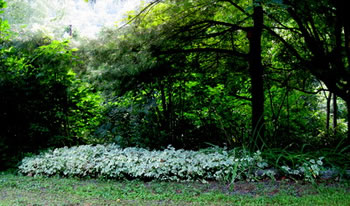
It’s attractive in a highly controlled area. But if you lack the patience to do that as I did, then it will crop up all over the place
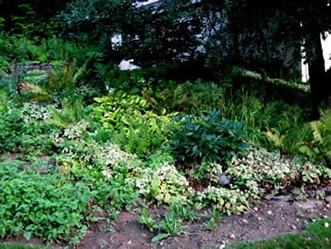
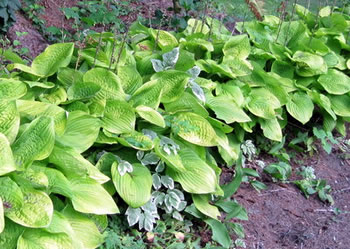
Until you begin to loathe the sight of it.
The same thing can happen when we’re in such a rush to get an animal that we don’t do our homework regarding those aforementioned physical, mental, and emotional environmental limits we all have. Or if we lack the patience to consider the variety of different nutritional, training, exercise, and medical options available for the animal and make a conscious choice of the one that best fits that animal’s and our own needs.
If I were forced to pick one quality that would distinguish those best equipped to work with animals, patience would be the one. But empathy is right up there, too.
Empathy. Gardening also teaches respect for other living beings. I don’t suggest that those planning to own or work with animals should plant a garden because, if you make a mistake and the plants die, it doesn’t matter. It does or it should matter. If we’re not sensitize to the consequences our actions have for life-forms we consider lesser in some way, how can we hope to interact in a meaningful way with those we consider more worthy of our attention?
This isn’t to say that I believe that gardening should be an all-positive experience any more than I see that as realistic for our relationship with any animals. Plants will die as a result of our ignorance and negligence, but also sometimes in spite of everything “right” we do to prevent this. And some animals will, too. In the garden, certain animals who pose a danger to the plants will be eliminated just as we eliminate those animals (including parasites) who threaten those animals we value more. The lesson is not to run away from or deny these realities, but instead to face them, accept any responsibility for our part in this, and try to minimize the damage.
 There are many more lessons we can learn from a planting a garden, or even planting something so simple as a packet of zinnia or radish seeds. But I’ll conclude with something I learned in an introductory botany course many years ago: A weed is just an out of place flower. Were you to visit my little house on the hill, you would quickly discover two things about my gardens. One is that you don’t have to look that far to find a weed. This is because I’ve found that what some people consider weeds can be quite attractive when placed in a suitable environment, just like some people and some animals.
There are many more lessons we can learn from a planting a garden, or even planting something so simple as a packet of zinnia or radish seeds. But I’ll conclude with something I learned in an introductory botany course many years ago: A weed is just an out of place flower. Were you to visit my little house on the hill, you would quickly discover two things about my gardens. One is that you don’t have to look that far to find a weed. This is because I’ve found that what some people consider weeds can be quite attractive when placed in a suitable environment, just like some people and some animals.
The second is that there are places where garden and woods merge and the line between cultivated and wild blurs. And so it is with even the most seemingly domesticated animal. No matter how much we may try to create and shape them to suit our needs, there will always be a part of them that lies beyond our reach.
If you have any comments regarding subject matter, favorite links, or anything you’d like to see discussed on or added to this site, please let me know at mm@mmilani.com.
I have a magnate on my refrigerator that says, “Change your shoes…Change your life.” The relationship between planting a garden and quality animal interactions may seem equally unconnected, but it’s not as far-fetched as you might think. Gardening teaches basic skills that carry over into all areas of life and I’d heartily recommend it for anyone who works with animals and/or wants a quality relationship with them. Consider the following and judge for yourself.
Knowing Your Limits. One of the first things that gardening teaches is to select plants or seeds that are compatible with your soil, climate, and degree of knowledge. This doesn’t mean that you can’t or shouldn’t consider something new and different. But if you do, it means that you have to make any changes necessary to ensure a compatible environment before you plant those seeds or plants.
For example, here’s a picture of my vegetable garden this year:
You might be thinking this is a good place to stop reading this commentary because I obviously don’t know the difference between a flower and a vegetable. But the truth is that this was a vegetable garden. But after two years of above average rainfall and other climatic changes that reduced my vegetable yield to next to nothing, I knew it was time to plant something else. I’ve always mixed flowers with the vegetables, but because I had no idea what this summer’s weather would bring, I decided to plant all flowers. I stuck with perennials with established track records surviving in a wide range of conditions. For additional color, I sowed a mixture of annual seeds, based on the hope that at least some of them would survive and even flourish in whatever conditions Mother Nature doled out this year.
Once you lose a plant or, worse, a whole garden because you didn’t take the time to understand your own and the limits or your environment, you’re more likely to think twice before buying or adopting animals from distant locations or losing your heart to a rare species, breed, or color before knowing those animals’ needs and ensuring that you can fulfill them.
Pruning. Gardening also teaches you that there are times when it’s necessary to cut a plant, shrub, or tree back in order for it to grow and flourish. Of all the lessons the garden has taught me, pruning and transplanting (more on that later) have been the hardest for me to learn. Remove too little and the plant won’t thrive. Remove too much and it will die. Timing is also important. Spring pruning is recommended for some plants, while fall pruning is optimum for others. If your timing is off, any benefits and even the plant could be lost.
For me, the hardest plants to prune were those I’d nursed for years that have lots of foliage, but few flowers or fruits. The thought of cutting back all that growth used to just about kill me, even though the science and logic behind the process was clear. But each time I summoned the courage to do it and saw the benefits the following year, it became easier.
A similar phenomenon can occur with animals. We invest in a particular feeding, training, exercise, and/or medical program and our animals do adequately, but never as well as we think they could or should. But the thought of starting over seems overwhelming after all we’ve invested in this approach. Then when finally muster the courage to start over—or things get so bad we have no choice—and we see the results, we wonder why we didn’t do it sooner.
Transplanting. Transplanting was another difficult lesson for me to learn and I learned it the hard way. I planted my seeds and when they sprouted, I couldn’t bear to thin them because I had no place to plant all the seedlings and didn’t want to lose them. As a result, I lost most of them anyway. And those that did survive didn’t do nearly as well as they would have had they had more room to grow.
But as the garden also teaches, nature is dynamic. Part of what looks like a mass of annuals in the first picture happened because the ideal time to transplant occurred when I was in Colorado this year. By the time I got back, weather conditions were such that it would have been more life-threatening to transplant than let them stay where they were. Even so, since then I’ve removed some plants that I can only describe as botanical bullies because they had such a suppressive effect on those around them.
With established perennials, I now accept that as soon as I get some of them to where I want them to be, it won’t be long until I’ll have to divide and transplant them if I want them to continue doing well. For example, in this bed the pink phlox are doing so well, they’re crowding out instead of complimenting the flowers behind them. Next year I’ll have to bite the bullet and divide the plants just as the first shoots poke out in the spring and move them to another location.
Meanwhile the plants growing behind them, a lovely daisy-like flower called Prairie Sun, are lost behind the taller phlox, so I plan to transplant them next spring, too, but for a different reason.
The plants in front of the phlox are hosta, a slow-growing clumping perennial that’s my idea of the perfect plant. Or it would be if it had just a bit more pizzazz. The nice thing about plants like this is that, the slower they grow, the less transplanting I need to do. But the slower they grow, the more unfinished the bed will look until they get established. That border was 20-odd years in the making.
Meanwhile, it’s hard to believe that, Mother Nature willing, this isolated lump of Gaillardia will one day merge with others I’ve planted in the beds by the front walk and live up to to their common name of blanket flower. When they do, they’ll cover all those unsightly rocks that are the norm in my soil.
Does transplanting have a counter-part in the animal world? I think it does. Granted we don’t think in terms of dividing and rehoming parts of the Saint Bernard who outgrew the tiny apartment. But sometimes we do have to face the fact that our limited space may not be enough for a high-energy animal, or that 4 dogs or 5 cats or 20 birds may be too many for us to provide quality care for on a daily basis, that the needs of some are crowding out the needs of others. In such cases, “transplanting” some of those animals to other homes where such care is available will enable them to do better.
Another variation on this theme is finding a new home for the animal with whom no meaningful bond exists. In spite of all the warm, fuzzy forever-home rhetoric with its guilt-inducing potential, the reality is that, just as we don’t bond with certain people for no logical reason, the same thing may occur with animals. To keep such an animal out of a sense of duty or guilt can lead to resentment of the time and space the animal takes up in our lives or indifference, neither of which will benefit the animal.
Patience. An old adage reminds us that patience is a virtue desired by many but possessed by few. Aside from pregnancy, I can’t think of anything that teaches this virtue more quickly and completely than gardening. Rant as we will, those seeds aren’t going to become plants overnight any more than they’ll produce flowers or vegetables as fast as we can download our email. Fume all we want, but it won’t stop the excess rain or drought, any more than it will increase or drop the temperature. Plant a plant advertised as “fast-growing” because we want our mental image of the perfect garden fulfilled as soon as possible and we may spend countless hours trying to get rid of it when it takes over.
I know this for a fact. This is a plant called Bishop’s weed, a name that should have been a tip-off but I was too impatient to notice.
It’s attractive in a highly controlled area. But if you lack the patience to do that as I did, then it will crop up all over the place
Until you begin to loathe the sight of it.
The same thing can happen when we’re in such a rush to get an animal that we don’t do our homework regarding those aforementioned physical, mental, and emotional environmental limits we all have. Or if we lack the patience to consider the variety of different nutritional, training, exercise, and medical options available for the animal and make a conscious choice of the one that best fits that animal’s and our own needs.
If I were forced to pick one quality that would distinguish those best equipped to work with animals, patience would be the one. But empathy is right up there, too.
Empathy. Gardening also teaches respect for other living beings. I don’t suggest that those planning to own or work with animals should plant a garden because, if you make a mistake and the plants die, it doesn’t matter. It does or it should matter. If we’re not sensitize to the consequences our actions have for life-forms we consider lesser in some way, how can we hope to interact in a meaningful way with those we consider more worthy of our attention?
This isn’t to say that I believe that gardening should be an all-positive experience any more than I see that as realistic for our relationship with any animals. Plants will die as a result of our ignorance and negligence, but also sometimes in spite of everything “right” we do to prevent this. And some animals will, too. In the garden, certain animals who pose a danger to the plants will be eliminated just as we eliminate those animals (including parasites) who threaten those animals we value more. The lesson is not to run away from or deny these realities, but instead to face them, accept any responsibility for our part in this, and try to minimize the damage.
The second is that there are places where garden and woods merge and the line between cultivated and wild blurs. And so it is with even the most seemingly domesticated animal. No matter how much we may try to create and shape them to suit our needs, there will always be a part of them that lies beyond our reach.
If you have any comments regarding subject matter, favorite links, or anything you’d like to see discussed on or added to this site, please let me know at mm@mmilani.com.